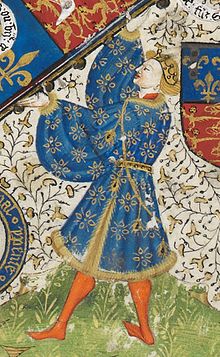Richard Plantagenet, Duke of York
| Richard of York | |
|---|---|

Richard in the frontispiece of the Talbot Shrewsbury Book, 1445
|
|
| Duke of York | |
| Predecessor | Edward of Norwich |
| Successor | Edward (IV) |
| Born | 21 September 1411 |
| Died | 30 December 1460 (aged 49) Wakefield, Yorkshire |
| Spouse | Cecily Neville |
| Issue | |
| House | House of York |
| Father | Richard of Conisburgh, 3rd Earl of Cambridge |
| Mother | Anne de Mortimer |
Richard of York, 3rd Duke of York KG (21 September 1411 – 30 December 1460), was a leading English magnate, a great-grandson of King Edward III through his father, and a great-great-great-grandson of the same king through his mother. He inherited vast estates and served in various offices of state in Ireland, France, and England, a country he ultimately governed as Lord Protector during the madness of King Henry VI. His conflicts with Henry's wife, Margaret of Anjou, and other members of Henry's court, as well as his competing claim on the throne, were a leading factor in the political upheaval of mid-fifteenth-century England, and a major cause of the Wars of the Roses. Richard eventually attempted to take the throne, but was dissuaded, although it was agreed that he would become king on Henry's death. But within a few weeks of securing this agreement, he died in battle.
Although Richard never became king himself, he was the father of King Edward IV and King Richard III.
Richard Plantagenet, 3rd Duke of York, was born on 21 September 1411, the son of Richard of Conisburgh, 3rd Earl of Cambridge by his wife Anne Mortimer, the daughter of Roger Mortimer, 4th Earl of March, and Eleanor Holland. Anne Mortimer was the great-granddaughter of Lionel of Antwerp, 1st Duke of Clarence, the second surviving son of King Edward III (1327–1377). This ancestry supplied Anne Mortimer, and her descendants the Dukes of York, with a claim, albeit not in a direct male line, to the English throne that was supposedly superior to that of the reigning House of Lancaster, descended from John of Gaunt the third son of King Edward III.
...
Wikipedia
